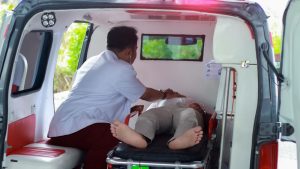Have you ever wondered what really happens when someone needs a Gili Meno ambulance to Bali during an emergency? When you’re surrounded by turquoise water, soft white sand, and that calm island vibe, it’s hard to imagine anything going wrong. But emergencies have a funny way of showing up uninvited—often when you least expect them.
And when they do happen, everything suddenly speeds up. Your heartbeat jumps, your mind races, and a quiet little voice whispers: “How do we get off this tiny island as fast as possible?”
Take a breath. You’re not alone.
This guide is here to be your calm in the chaos.
After years of assisting travelers and expats with medical transfers, I’ve seen the reality of emergency evacuations from the Gilis. So in this article, we’ll walk through exactly how a Gili Meno ambulance to Bali works, what options exist, who to call, and what most travelers never find out until it’s too late.
Think of this as your friendly, knowledgeable travel buddy talking you through it—because that’s exactly the tone we’re going for.
Why Emergency Transport Matters on a Remote Island
Imagine waking up in Gili Meno to the sound of soft waves. The morning air is cool, the sand still carries the night’s chill, and everything feels slow and peaceful. Then suddenly—an accident. A severe allergy. A heart issue. A diving injury.
On an island with no cars, no scooters, no hospitals, the situation instantly becomes serious.
That’s where services like ambulance Gili, Gili emergency service, and Gili medical evacuation step in. You don’t notice them when everything is fine, but when things go wrong, they become absolute lifesavers.
I still remember helping a traveler who had a sudden asthma attack years ago. The sound of the waves, the panic in her breathing, the rush of the responders—it’s the kind of moment that stays with you. A simple micro-story, but it taught me how vital preparedness is on a small island.
How the Gili Meno Ambulance to Bali System Actually Works
Here’s the first thing most travelers don’t realize:
There are no four-wheeled ambulances on Gili Meno.
So the entire Gili Meno ambulance to Bali process is actually a multi-step medical evacuation system designed for efficiency.
Let me break it down in a simple, friendly way:
1. First Responders Arrive on the Island
Local responders reach patients using electric carts, horse-drawn carts, or stretchers. It might sound humble, but when they arrive—calm, steady, and prepared—it feels like seeing tropical superheroes in action.
2. Transfer to a Medical Speedboat
The official ambulance Gili team then escorts the patient to a medical speedboat. These boats usually have oxygen, basic equipment, and sometimes a medic onboard.
This is the heart of Gili medical evacuation: stabilize, secure, and move fast.
3. Crossing from Gili Meno to Bali or Lombok
Most Gili Meno ambulance to Bali transfers head to Padang Bai, though Lombok (Bangsal Harbor) is also an option.
The trip normally takes 1.5–2 hours depending on sea conditions.
I once joined a night evacuation—dark ocean like black velvet, the steady hum of the engine, the quiet focus of the medic. It felt surreal yet incredibly professional.
4. Ground Ambulance Pickup in Bali
By the time the boat arrives, an ambulance on land is already waiting. The handover is quick and coordinated, and within minutes the patient is on the way to a major hospital.
That entire chain—Gili responders → medical boat → Bali ambulance—is what people call a Gili Meno ambulance to Bali service.
When You Actually Need a Gili Meno Ambulance to Bali
Some people hesitate, unsure whether their condition is “serious enough” for evacuation.
Here’s a simple rule: if it feels serious, it probably is.
Conditions that require immediate evacuation include:
-
Chest pain or suspected heart attack
-
Severe allergic reactions (anaphylaxis)
-
Major fractures
-
Head trauma
-
Serious respiratory distress
-
Diving-related injuries (barotrauma, DCS)
-
Heavy bleeding or deep wounds
In these cases, delaying help is not an option.
This is exactly why Gili emergency service exists.
Different Medical Transport Options Available
Not all evacuations are the same. Depending on the patient’s condition, there are several transportation choices:
1. Medical Speedboat (Most Common Option)
This is the main method for a Gili Meno ambulance to Bali evacuation.
Fast, reliable, available day and night—perfect for moderate to severe cases.
2. Private Fast Boat Charter
Suitable for non-critical conditions. It’s more affordable but not medically equipped.
3. Helicopter Evacuation (Rare but Possible)
Usually from Lombok, not directly from Gili Meno.
It’s the fastest…but also the most expensive.
Still, for the majority of Gili medical evacuation cases, medical speedboats are the practical and effective solution.
How to Prepare for a Medical Emergency (So You Don’t Panic Later)
This part is where many travelers later say, “I wish I knew this sooner.”
1. Save Emergency Numbers
Like carrying an umbrella—you don’t think about it until it rains.
2. Know How the Evacuation Works
You already understand the process now. Awareness lowers panic.
3. Get Travel Insurance
A medical evacuation isn’t cheap. A good insurance policy can make a world of difference if you ever need a Gili Meno ambulance to Bali service.
4. Bring Your Own Medication
The island has no full pharmacies. Always bring essentials.
Things Travelers Often Don’t Know (But Should)
Here are some insider tips that rarely appear in guidebooks:
-
Afternoon waves can be higher, slightly extending the crossing.
-
Evacuation teams use radio communication to coordinate.
-
Medics often have extensive experience with tourist injuries.
-
Evacuations continue even at night or under cloudy weather.
These little details show how well-established the Gili Meno ambulance to Bali networks really are.
A Real-Life Evacuation Story (So You Can Picture It Clearly)
Let me paint you a picture.
A few years ago, a traveler injured his knee badly while snorkeling. I happened to be nearby. The blue water sparkled under the sun, but his face was pale with pain.
The Gili emergency service arrived in under ten minutes. Their presence alone shifted the mood—they were calm, precise, reassuring. You could almost feel the tension drop in the air.
When the medical speedboat docked, the paramedics secured the injury, stabilized him, and prepared the equipment. The sea breeze mixed with the urgency of the moment—an oddly cinematic feeling.
The nighttime transfer to Bali felt like traveling through a tunnel of darkness, guided only by professionalism and protocol. That’s when it hit me: a Gili Meno ambulance to Bali isn’t just logistics—it’s a lifeline.
Stay Prepared, Even in Paradise
Gili Meno feels like paradise—quiet, gentle, and peaceful. But paradise doesn’t come with a hospital, and that’s why being prepared matters.
Knowing that Gili Meno ambulance to Bali services exist gives travelers incredible peace of mind. With the right insurance, the right contacts, and a bit of awareness, you can enjoy your holiday fully while knowing you’re protected if the unexpected happens.
And honestly… that sense of safety makes the island feel even more magical.












